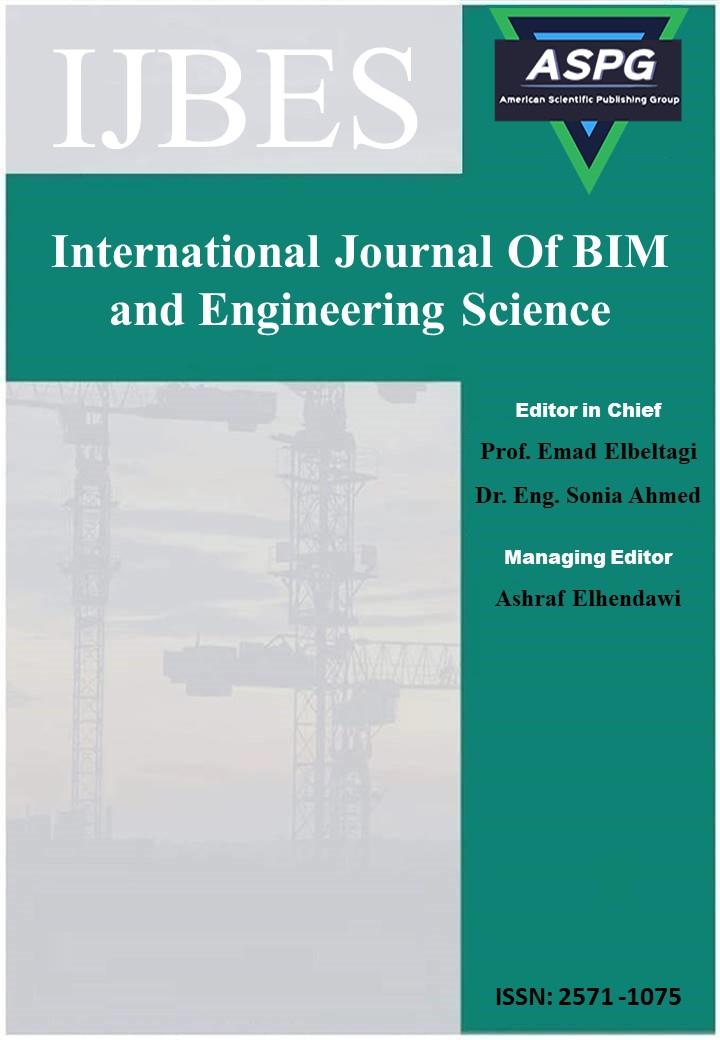

Volume 11 , Issue 1 , PP: 13-23, 2025 | Cite this article as | XML | Html | PDF | Full Length Article
Nisren Sharief 1 * , Bashar Abd Alnoor 2 , Khaled Al-fahed 3
Doi: https://doi.org/10.54216/IJBES.110102
Digital transformation is crucial for construction projects due to its numerous benefits, including increased productivity and improved collaborative environments. This research discusses the stages, components, and strategies that lead construction projects to digital transformation. Furthermore, it aims to advance the technological process of 3D digitization in built environments and simplify management operations in the construction phase through digital methodologies. To achieve this, an integrated framework combining Building Information Modeling (BIM) and Computerized Maintenance Management Systems (CMMS) applications is proposed. By using these integrated models, facility management is simulated within a 3D environment via a CMMS. The results indicated that digital models and BIM could indeed be integrated through direct linkage mechanisms without compromising the efficiency of information synchronization and management. This 3D representation allowed for a better understanding of dynamics and spatial interactions, facilitating quicker identification of potential issues and more efficient maintenance operations. Therefore, integrating these advanced digital models not only improves operational efficiency, but also enhances collaborative environments. The proposed model represents what is known as a Digital Twin, a comprehensive system that manages all information flows associated with a building throughout its lifecycle.
Digital Transformation , Facility Management , Digital Twin , Maintenance , Building Information Management
[1] B. Atkin and A. Brooks, Total Facilities Management, 3rd ed. Chichester, UK: Wiley-Blackwell, 2009.
[2] B. Atkin and A. Brooks, Total Facility Management. John Wiley & Sons, 2014.
[3] A. Bosch, L. Volker, and A. Koutamanis, “BIM in the operations stage: bottlenecks and implications for owners,” Built Environment Project and Asset Management, vol. 5, no. 3, pp. 331–343, 2015, doi: 10.1108/BEPAM-03-2014-0017.
[4] A. Costin, N. Pradhanananga, J. Teizer, and E. Marks, “Real-Time Resource Location Tracking in Building Information Models (BIM),” in Cooperative Design, Visualization, and Engineering: 9th International Conference, Osaka, Japan, Sept. 2–5, 2012.
[5] W. Chen, K. Chen, J. C. Cheng, Q. Wang, and V. J. Gan, “BIM-based framework for automatic scheduling of facility maintenance work orders,” Automation in Construction, vol. 91, pp. 15–30, 2018, doi: 10.1016/j.autcon.2018.03.007.
[6] C. M. Eastman, C. Eastman, P. Teicholz, and R. Sacks, BIM Handbook: A Guide to Building Information Modeling for Owners, Managers, Designers, Engineers and Contractors. John Wiley & Sons, 2011.
[7] A. Hallin, E. Lindell, B. Jonsson, et al., “Digital transformation and power relations. Interpretative repertoires of digitalisation in the Swedish steel industry,” Scandinavian Journal of Management, vol. 38, no. 1, 2022, doi: 10.1016/j.scaman.2021.101183.
[8] M. A. Hassanain, T. M. Froese, and D. J. Vanier, “Development of a maintenance management model based on IAI standards,” Artificial Intelligence in Engineering, vol. 15, no. 2, pp. 177–193, 2001, doi: 10.1016/S0954-1810(01)00015-2.
[9] M. A. Hassanain, T. M. Froese, and D. J. Vanier, “Implementation of a distributed, model-based integrated asset management system,” Journal of Information Technology in Construction (ITcon), vol. 8, no. 10, pp. 119–134, 2003. [Online]. Available: http://www.itcon.org/2003/10
[10] F. Ivarsson, “Applying Framing Theory in Digital Transformation Research: Suggestions for Future Research,” in Proceedings of the 55th Hawaii International Conference on System Sciences (HICSS55), 2022, pp. 6373–6382. [Online]. Available: https://hdl.handle.net/10125/80113
[11] S. H. Khajavi, N. H. Motlagh, A. Jaribion, L. C. Werner, and J. Holmstrom, “Digital Twin: Vision, Benefits, Boundaries, and Creation for Buildings,” IEEE Access, vol. 7, pp. 147406–147419, 2019, doi: 10.1109/ACCESS.2019.2946515.
[12] J. Koeleman, M. J. Ribeirinho, D. Rockhill, E. Sjödin, and G. Strube, “Decoding digital,” 2019.
[13] A. O. Olanipekun and M. Sutrisna, “Facilitating Digital Transformation in Construction—A Systematic Review of the Current State of the Art,” Frontiers in Built Environment, 2021, doi: 10.3389/fbuil.2021.660758.
[14] P. Parsanezhad and J. Dimyadi, “Effective facility management and operations via a BIM-based integrated information system,” in Proceedings of the 2014 CIB Conference on Facilities Management (CFM), Copenhagen, 2013.
[15] P. Parsanezhad, “An overview of information logistics for FM&O business processes,” in European Conference on Product and Process Modelling, Vienna, Austria, Sept. 17–19, 2014.
[16] Q. Qi and F. Tao, “Digital Twin and Big Data Towards Smart Manufacturing and Industry 4.0: 360 Degree Comparison,” IEEE Access, vol. 6, pp. 3585–3593, 2018, doi: 10.1109/ACCESS.2018.2793265.
[17] A. Redmon, A. Hore, M. Alshawi, and R. West, “Exploring how information exchanges can be enhanced through Cloud BIM,” Journal of Automation in Construction, vol. 24, 2012. [Online]. Available: https://sciendo.com/pdf/10.2478/picbe-2018-0085
[18] R. Volk, J. Stengel, and F. Schultmann, “Building Information Modeling (BIM) for existing buildings—Literature review and future needs,” Automation in Construction, vol. 38, pp. 109–127, 2014, doi: 10.1016/j.autcon.2013.10.023.
[19] P. C. Verhoef et al., “Digital Transformation: A Multidisciplinary Reflection and Research Agenda,” Journal of Business Research, vol. 122, pp. 889–901, 2019. [Online]. Available: https://www.sciencedirect.com/science/article/pii/S014829631930547
[20] Y. Wang, X. Wang, J. Wang, P. Yung, and J. Gu, “Engagement of Facilities Management in Design Stage through BIM: Framework and a Case Study,” Advances in Civil Engineering, 2013, doi: 10.1016/j.aei.2016.05.004.
[21] B. Wang, H. Li, Y. Rezgui, A. Bradley, and H. N. Ong, “BIM Based Virtual Environment for Fire Emergency Evacuation,” The Scientific World Journal, 2014.
[22] M. Yalcinkaya and V. Singh, “Building Information Modeling (BIM) for Facilities Management—Literature Review and Future Needs,” IFIP Advances in Information and Communication Technology, vol. 442, pp. 1–10, 2014.